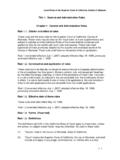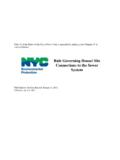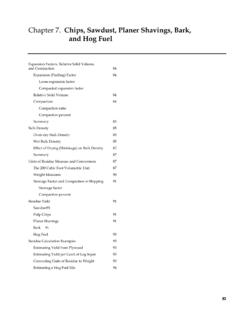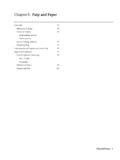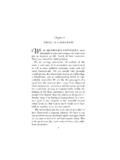Transcription of Chapter 9
1 Design for Strength and Endurance Chapter 9 _____Fluctuating Load Analysis - - Zorowski 2002 189 Chapter 9 Fluctuating Load Analysis Screen Titles Fluctuating Stresses Generic Stress-Time Behavior Stress-Time Relations Modified Goodman Diagram Mean/Fluctuating Stress Diagram Soderberg Failure Theory Goodman Failure Theory Gerber Failure Theory Sample Problem 1 Problem 1 Solution Torsional Fatigue Combined Loading Modes Sample Problem 2 Problem 2 Solution Cumulative Fatigue Damage Palmgren-Minor Theory Sample Problem 3 Problem 3 Solution Mason s Modification Review Exercise Off Line Exercise Design for Strength and Endurance Chapter 9 _____Fluctuating Load Analysis - - Zorowski 2002 190 Design for Strength and Endurance Chapter 9 _____Fluctuating Load Analysis - - Zorowski 2002 191 1.
2 Title page Chapter 9 continues the study of the fatigue analysis and behavior of mechanical parts. Attention is now directed to elements subjected to general fluctuating loads as contrasted to complete reversed stress states treated in Chapter 8. The presentation begins with defining generic parameters to represent fluctuating loads. General fatigue failure under fluctuating normal stress loading is then discussed and three specific failure theories are introduced together with fatigue under fluctuating torsional stresses. A method of fatigue analysis for combined stress states is also covered. The Chapter concludes with two methods of determining the effects of cumulative fatigue damage due to multiple loads applied for different durations of cyclic application.
3 Several exercise problems and extended sample problems are included to demonstrate the application of the subject content. 2. Page Index Listed on this page are all the individual pages in Chapter 9 with the exception of the exercise problems. Each page title is hyperlinked to its specific page and can be accessed by clicking on the title. It is suggested that the reader first proceed through all pages sequentially. Clicking on the text button at the bottom of the page provides a pop up window with the text for that page. The text page is closed by clicking on the x in the top right corner of the frame. Clicking on the index button returns the presentation to the page index of Chapter 9. Design for Strength and Endurance Chapter 9 _____Fluctuating Load Analysis - - Zorowski 2002 192 3.
4 Fluctuating Stresses Chapter 8 considered the fatigue behavior of mechanical elements subjected to complete reversed stress states in which the stress level varied from some specific negative value to the same positive value and then repeated this behavior continuously. This Chapter will deal with repeated stress states that may vary from zero to some specific value and then back to zero continuously or even more generally from some minimum value to a different numeric positive value and then back to the minimum value repeatedly. In this instance the variation will possess some mean value of stress that will lie between the minimum and maximum value of the applied stress state. 4. Generic Stress Time Behavior Depicted in the figure is an idealized general fluctuating stress versus time behavior curve.
5 Although this is represented as a smooth sinusoidal function the parameters that will be used to generalize its description will be the same irrespective of the specific shape of the curve provided it is periodic in behavior. In other words the shape could be saw tooth or a square wave, it would still be characterized for fatigue analysis in the same way. The four parameters used to define the curves characteristics for the fatigue discussions and analyses to follow are its maximum value, sigma max, its minimum value, sigma min, its mean value, sigma m and its alternating value about the mean, sigma a. Design for Strength and Endurance Chapter 9 _____Fluctuating Load Analysis - - Zorowski 2002 193 5.
6 Stress Time Relations Of primary interest in the developments to follow are the mean stress and the alternating stress components. The mean stress is of course just the average of the two extreme values or one half the sum of the maximum and minimum values. The alternating stress, which is sometimes referred to as the stress amplitude, is simply one half the difference between the maximum and minimum values. Of occasional value is the stress ratio, R, defined as the minimum stress divided by the maximum stress and the amplitude ratio, A, which is the alternating component divided by the mean component. Design for Strength and Endurance Chapter 9 _____Fluctuating Load Analysis - - Zorowski 2002 194 6.
7 Modified Goodman Diagram Fatigue failure behavior from experiments conducted under different combinations of fluctuating normal stress loading states are conveniently presented and described on a Modified Goodman Diagram . In this representation the mean stress is plotted on the horizontal axis and all other stresses are plotted vertically with tension to the right and up. A 45-degree line from the origin in the first quadrant represents the mean stress of an applied stress state. When the mean stress is zero fatigue failure is represented by plus and minus the endurance stress on the vertical axis. This is indicated by the red dot at the origin and the green dot on the vertical axis. A green dot on the negative vertical axis is not shown due to space limitations.
8 Now consider the case where the mean stress plus the stress amplitude are equal to the yield stress of the material. This is illustrated by the second set of red and green dots. Assuming that yielding is considered as undesirable, that is equivalent to failure , then lines drawn from the second set of green dots to the positive and negative endurance limits on the vertical axes corresponds to a proposed criteria for defining fatigue failure for a generalized fluctuating stress loading. The failure boundary is completed by extending the line from the upper green dot on the maximum stress line to the value of the yield stress on the mean stress line and from that point to the lower green dot on the minimum stress line. Note that when the mean stress is equal to the yield stress no alternating stress is necessary to produce yielding.
9 However, as the mean stress decreases the corresponding value of alternating stress required to define fatigue failure increases as indicated by the third set of red and green dots. Thus the area enclosed by the red boundary in the first quadrant proposes states of stress for which fatigue failure will not occur. Experimental results have verified that this is a good approximation for defining fatigue behavior under a general fluctuating state of stress. Design for Strength and Endurance Chapter 9 _____Fluctuating Load Analysis - - Zorowski 2002 195 7. Mean/Fluctuating Stress Diagram A second way of depicting fatigue failure under the action of a fluctuating stress state is obtained by plotting the mean stress horizontally and the alternating stress vertically.
10 The yield stress of the material is first plotted on both the vertical axis and the positive and negative axes. Then diagonal lines are used to join these three points as illustrated on the graphic. Next the endurance limit is plotted on the vertical axis together with the ultimate tensile strength on the horizontal axis. In the first quadrant a line is drawn from the endurance limit to the tensile strength. Any combination of alternating stress and mean stress that falls on the lower of the fatigue line or yield line, indicated by the heavy red boundary, defines a condition of failure either by fatigue or yielding. It has been determined experimentally that compressive mean stresses have virtually no effect on reducing the fatigue strength of a mechanical element.
